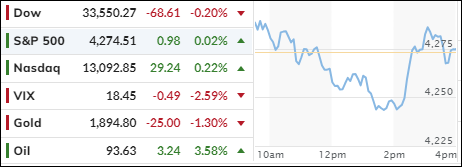
- Moving the markets
The stock market experienced a wild ride on Wednesday as Wall Street attempted to recover from steep losses seen in the previous session. This rollercoaster was fueled by a dip and then a rip in Treasury yields and the release of positive economic data.
The benchmark 10-year Treasury yield rallied above the 4.6% mark. Similarly, the 2-year Treasury yield soared as well but retreated into the close.
In other news, the Commerce Department reported that orders for durable goods rose 0.2% in August, surpassing Dow Jones’ estimate of a 0.5% decline.
Rising rates have recently exerted pressure on stocks due to concerns that the Federal Reserve might maintain tighter monetary policy for a longer duration than anticipated. On Tuesday, the S&P 500 fell below the key 4,300 level for the first time since June, following disappointing new home sales and consumer confidence data.
The market is currently living up to its seasonally weak September, and its volatility is expected to extend into October. The future direction will depend on earnings season around midmonth, which will reveal whether current market conditions will improve or if we will witness a “red October” outcome.
Inflation remains a significant concern, as investors are anxious about not only the elevated rate but also how it impacts companies with higher borrowing costs. Currently, equities are trading as though hope and confidence are dwindling out of the system, with even a much-hoped-for short squeeze providing little assistance.
Financial conditions are tightening significantly, reaching their tightest levels since November 2022. Meanwhile, real rates are increasing, and the S&P 500 is beginning to retreat, resembling the alligator jaw closing.
The question remains: will this process accelerate?
2. “Buy” Cycle (12/1/22 to 9/21/2023)
The current Domestic Buy cycle began on December 1, 2022, and concluded on September 21, 2023, at which time we liquidated our holdings in “broadly diversified domestic ETFs and mutual funds”.
Although our International TTI has experienced a slight dip below its long-term trend line, it was not significant enough to signal the end of that cycle. However, given the potential “Sell” on the horizon, I do not recommend considering this arena as an investment choice.
We have kept some selected sector funds. To make informed investment decisions based on your risk tolerance, you can refer to my Thursday StatSheet and Saturday’s “ETFs on the Cutline” report.
Considering the current turbulent times, it is prudent for conservative investors to remain in money market funds—not bond funds—on the sidelines.
3. Trend Tracking Indexes (TTIs)
The markets experienced significant volatility, with the S&P 500 ending the day unchanged. Despite inconsistent bullish sentiment, it was insufficient to drive the indexes out of the doldrums.
Our Domestic TTI experienced only a marginal change, while the international TTI slipped slightly further into bear market territory. It is highly probable that we will exit that arena by Friday.
This is how we closed 09/27/2023:
Domestic TTI: -2.98% below its M/A (prior close -3.01%)—Sell signal effective 9/22/2023.
International TTI: -0.32% below its M/A (prior close -0.04%)—Buy signal effective 12/1/2022.
All linked charts above are courtesy of Bloomberg via ZeroHedge.
Contact Ulli